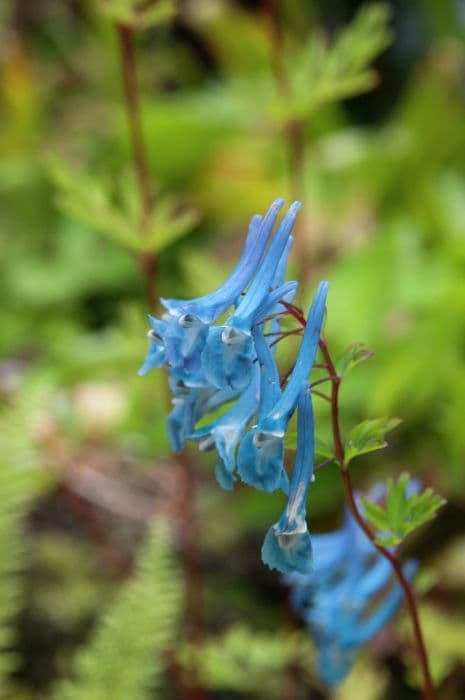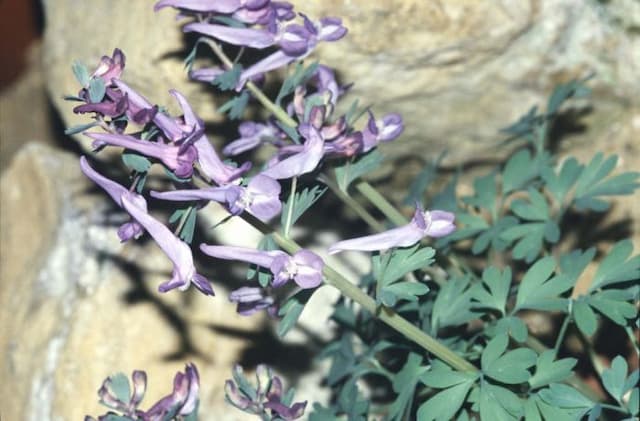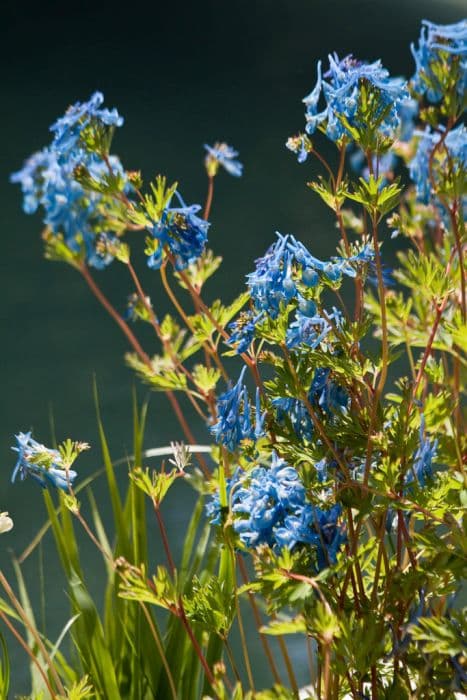Papaver commutatum 'Ladybird'

ABOUT
Papaver commutatum 'Ladybird', commonly known as the Ladybird Poppy, is a striking and vibrant flowering plant. It is well-known for its decorative and showy flowers, which bear a bold resemblance to the red-and-black spotted ladybird beetle, inspiring its common name. The petals of the Ladybird Poppy are a vivid scarlet red, with each petal typically showcasing a large, velvety black spot at the base, giving the impression of a ladybird's spotted wings. The plant has a delicate and airy quality, with fine, intricately divided leaves that are a soft green color, forming a feathery backdrop to the bold blossoms. These leaves are intricately lobed and provide a lacy appearance, contrasting beautifully with the rounded silhouette of the flowers. The blooms themselves are comprised of four rounded petals that form a cup-like structure, offering a simple yet stunning form. At the center of each flower, there is a conspicuous cluster of black stamens, which adds to the dramatic coloring and helps to attract pollinators such as bees. The Ladybird Poppy presents a carefree and naturalistic feel to garden settings, contributing bursts of bright color that stand out against the softer tones of surrounding foliage. Its appearance encapsulates a sense of wild beauty that can enhance the visual appeal of any garden space where the size of the plant is suitable.
About this plant
 Names
NamesFamily
Papaveraceae.
Synonyms
Ladybird Poppy, Caucasian Scarlet Poppy, Red Field Poppy, American Legion Poppy.
Common names
Papaver commutatum 'Ladybird'.
 Toxicity
ToxicityTo humans
Ladybird Poppy is considered toxic to humans. While it does not usually contain the same potency of alkaloids found in some other Papaver species, it still contains compounds that can be harmful when ingested. Symptoms of poisoning from poppies can include nausea, vomiting, drowsiness, respiratory depression, and in severe cases, could lead to coma or death. Therefore, any ingestion of the Ladybird Poppy should be treated with caution, and medical attention should be sought immediately in the event of suspected poisoning.
To pets
Ladybird Poppy is also toxic to pets. Like in humans, ingestion of any part of the plant can lead to signs of toxicity. Symptoms in pets may include gastrointestinal upset, such as vomiting and diarrhea, as well as central nervous system depression, which can manifest as drowsiness or incoordination. In severe cases, ingestion can lead to respiratory distress and even be fatal. If you suspect your pet has ingested Ladybird Poppy, it is important to seek veterinary care immediately.
 Characteristics
CharacteristicsLife cycle
Annuals
Foliage type
Deciduous
Color of leaves
Green
Flower color
Red
Height
1 feet 4 inches (40 cm)
Spread
1 feet (30 cm)
Plant type
Herb
Hardiness zones
8
Native area
Caucasus
Benefits
 General Benefits
General Benefits- Attracts Pollinators: Ladybird poppies are known to attract bees and other beneficial insects, which are essential for pollination and maintaining a healthy ecosystem.
- Aesthetic Appeal: With its striking red flowers with black spots, the Ladybird poppy adds vivid color and beauty to any garden landscape.
- Easy to Grow: Ladybird poppy is a hardy plant that is relatively easy to grow and can thrive in a variety of soil types, making it suitable for novice gardeners.
- Self-seeding: Once established, Ladybird poppies can self-seed, ensuring that the garden is replenished with new plants year after year without additional effort.
- Drought Tolerant: Ladybird poppy is drought-resistant, making it a good choice for gardens in areas that experience dry spells.
- Wildlife Habitat: The dense foliage and flowers of the Ladybird poppy can provide shelter and habitat for small wildlife and beneficial insects.
- Seasonal Interest: Ladybird poppies have a distinct blooming season that can provide visual interest in the garden during spring and early summer.
- Educational Interest: Growing Ladybird poppies can be an educational experience, offering lessons in plant biology, ecology, and the importance of pollinators.
 Medical Properties
Medical PropertiesThis plant is not used for medical purposes.
 Air-purifying Qualities
Air-purifying QualitiesThis plant is not specifically known for air purifying qualities.
 Other Uses
Other Uses- Ladybird poppy seeds can be used in the creation of natural dyes, with the petals offering a spectrum of red and pink hues.
- The stems and seed pods of Ladybird poppy can be used in dried floral arrangements or for craft projects to add an unusual texture and shape.
- The flowers can also be used as a natural source of color for artisan soaps, giving them a unique appearance without the use of artificial dyes.
- Ladybird poppy petals can serve as an inspiration for artists and designers, influencing patterns and colors in fashion and home decor.
- The plant can work as a visual barrier in the garden, their dense growth providing modest privacy during the blooming season.
- Ladybird poppy can be part of educational projects in schools, teaching children about the lifecycle of plants and pollinator attraction.
- Its vibrant red flowers can be used in photography, serving as a striking natural backdrop for portraits or macro photography.
- They can be used as a natural confetti, with the petals being biodegradable and more environmentally friendly than plastic alternatives.
- Ladybird poppy can be cultivated for plant competitions and horticultural shows, being appreciated for their distinctive colors and markings.
- The plant's ability to self-seed can be harnessed to create 'guerrilla gardens' in urban settings, bringing beauty to neglected or underdeveloped spaces.
Interesting Facts
 Feng Shui
Feng ShuiThe Ladybird Poppy is not used in Feng Shui practice.
 Zodiac Sign Compitability
Zodiac Sign CompitabilityThe Ladybird Poppy is not used in astrology practice.
 Plant Symbolism
Plant Symbolism- Remembrance: As a member of the poppy family, the Ladybird poppy is often associated with remembrance, particularly in contexts relating to war and fallen soldiers due to the widespread use of the red poppy as a symbol for Remembrance Day.
- Peace: Poppies have been used as a symbol of peace and death's eternal sleep, expressing a hope for a peaceful future.
- Resilience: Poppies can represent resilience as they are known to grow in disturbed soils, often those impacted by war.
- Beauty and Consolation: The striking red color of the Ladybird poppy can symbolize both beauty in sorrow and the consolation that beauty can provide even in times of tragedy.
- Sleep and Oblivion: Due to the sedative properties historically associated with certain types of poppies, the Ladybird poppy can also represent sleep, rest, and oblivion.
 Water
WaterLadybird Poppies should be watered regularly, providing about 1 inch of water per week. Adjust the watering schedule during periods of rainfall to prevent overwatering. It's best to water these plants deeply and infrequently to encourage deep root growth. Water at the base of the plant to avoid wetting the foliage, which can lead to fungal diseases. During the hot summer months, they may require additional water, so always check the soil moisture by feeling the soil a few inches below the surface and water if it is dry.
 Light
LightLadybird Poppies thrive in full sun, where they can receive at least 6 to 8 hours of direct sunlight per day. They perform best when planted in a location that gets morning sun and is protected from the intense heat of late afternoon sun in hotter climates. Ensure they are placed in a spot where they're exposed to unfiltered natural light to encourage strong growth and prolific blooming.
 Temperature
TemperatureLadybird Poppies prefer moderate temperatures and will grow well when daytime temperatures are between 60°F and 70°F. They can survive minimum temperatures down to about 28°F but are not frost-hardy and may die back if exposed to harsh frost. The ideal growing conditions include cool to warm days and cooler nights, consistent with their native temperate environments.
 Pruning
PruningPruning Ladybird Poppies is mainly done to remove spent blooms, a process known as deadheading, which encourages further flowering. After the initial flowering period, cut back the stems to just above the base of the plant to promote a second bloom. Pruning is also necessary to remove any withered or unhealthy leaves and stems to maintain plant health. The best time for pruning is late summer after flowering has finished.
 Cleaning
CleaningAs needed
 Soil
SoilLadybird poppy thrives in well-draining soil mixed with sand or grit and some compost for nutrients. The ideal soil pH for this plant is slightly acidic to neutral, ranging from 6.0 to 7.0.
 Repotting
RepottingLadybird poppies are generally not repotted as they are annuals and complete their life cycle within one growing season.
 Humidity & Misting
Humidity & MistingLadybird poppies prefer average humidity conditions and do not require special humidity adjustments.
 Suitable locations
Suitable locationsIndoor
Ensure bright light, well-draining soil, and cool temperatures.
Outdoor
Plant in full sun, well-draining soil, after frost danger.
Hardiness zone
2-8 USDA.
 Life cycle
Life cycleThe Ladybird Poppy begins its life as a seed planted in well-draining soil, ideally in the fall or early spring. Germination occurs within 14-28 days after sowing, with the emergence of a rosette of leaves close to the ground. As the plant matures, it develops a sturdy stem with silver-green, hairy leaves and buds form atop the stem. The buds open to reveal the characteristic bright red petals with a black spot at the base, resembling a ladybug, which bloom in late spring to early summer. After pollination by insects, the flowers produce distinctive seed pods that, when mature, release their seeds to the surrounding soil. The plant completes its annual life cycle by dying back after seed dispersal, but new growth can occur from self-sown seeds the following season.
 Propogation
PropogationPropogation time
Spring-Early Summer
The Ladybird poppy is commonly propagated by seed. The best time to sow Ladybird poppy seeds is in early spring or fall when the soil can be worked and is not frozen. In spring, you can scatter the seeds directly on top of prepared soil where you want the plants to grow, as these seeds need light to germinate; covering them with soil can prevent germination. To encourage germination, keep the soil moist but not waterlogged until seedlings emerge, which typically occurs in 14 to 28 days. Thin the seedlings to about 6 to 8 inches apart to allow plants enough space to grow to their full size.









